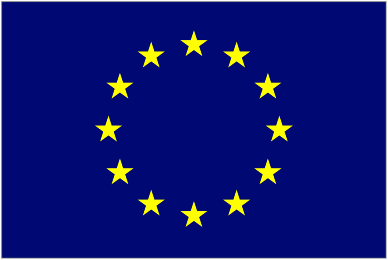

Peace Monuments Related
to the European Union (EC)


Right click image to enlarge.
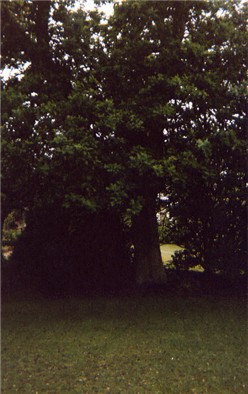

July 14, 1870 - Chêne des Etats-Unis d'Europe / United States of Europe Oak, au fond du jardin, Hauteville House (qv), 38 rue Hauteville, St. Peter Port (Guernsey). "Victor Hugo planta le 14 juillet 1870, quelques jours avant la déclaration de guerre de la France à la Prusse. 'Aujourd'hui 14 juillet 1870 [Bastille Day], à une heure de l'après-midi, mon jardinier Tourtel m'assistant en présence de mon fils Charles, petit Georges et petite Jeanne étant là, j'ai planté dans mon jardin le gland [acorn] d'où sortira le chêne que je baptise : "Chêne des Etats-Unis d'Europe." Dans une lettre à Paul Meurice, il écrivit : ' Il ne peut sortir de cette guerre que la fin des guerres et que les Etats-Unis d'Europe. Vous les verrez. Je ne les verrai pas. Pourquoi? C'est parce que je les ai prédits. J'ai le premier, le 17 juillet 1851, prononcé (au milieu des huées) ce mot : "les Etats-Unis d'Europe". Donc j'en serai exclu. Jamais les Moïses ne virent les Chanaans.' Le 13 septembre 1870, de retour en France, il note : 'Julie (jeune soeur de Madame Hugo qui continuera à habiter Hauteville après le départ de Victor Hugo en 1870) m'écrit de Guernesey [sic] que le gland planté par moi le 14 juillet a germé. Le chêne des Etats-Unis d'Europe est sorti de terre le 5 septembre, jour de ma rentrée à Paris.'" Information courtesy of Gerard Lössbroek.

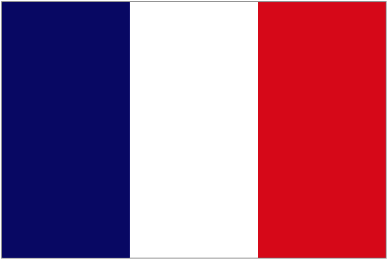
1953 - Bridge of Europe, across Rhine River between Strasbourg (France) & Kehl (Germany). "Permanent artistic installation, a bond between two countries for which the border formerly seemed & wanted to be insuperable. According to Roland Ries, then mayor of Strasbourg, 'Here, it is indeed Europe, because this bridge connects two countries that have been torn apart for a long time; the reconciliation of these two countries is today one of the surest supports of the European construction.'"

1965 - Bâtiment Alcide de Gasperi (ou bâtiment "Tour" du Parlement européen), Quartier Européen du Kirchberg (Luxembourg). "Construit de 1960 à 1965, constitue avec ses 22 étages le premier 'gratte-ciel' de la ville de Luxembourg." Houses the Secretariat of the European Parliament.

Date? - L'ancien hémicyle du Parlement européen à Luxembourg, aujourd'hui un centre de conférence européen.


After 1985 - "Schengen Agreement" monument, near Moselle bridge, Schengen (Luxembourg). "Three steel pillars, each with a star represent the first participant countries of the Schengen Agreement, being France, Germany and the Benelux countries, who met here in the triangle where the borders of Germany, France, and Luxembourg meet... This is a treaty signed in 1985, on the river-boat "Princesse Marie-Astrid," providing for the removal of systematic border controls between the participating countries."
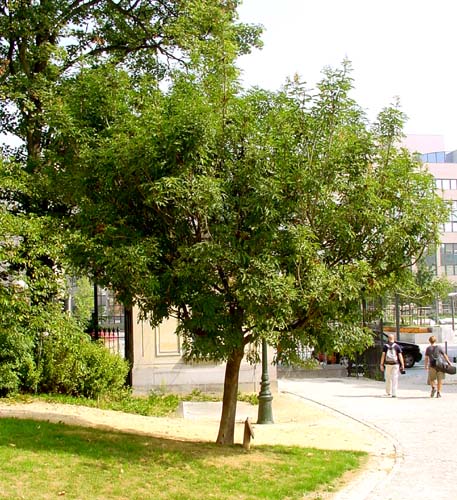

T
R
E
EJune 4, 1991 - Sri Chinmoy Peace Tree, Beliardstraat, Leopoldpark, Brussels (Belgium). Plaque: "This tree is dedicated to humanity’s aspiration for World Peace. From man’s inner realisation of peace, World Peace will grow and mankind will become a Oneness-World Peace-Family. In this process the oneness of the European nations is a significant achievement, therefore this tree is also dedicated to the United Europe. This peace tree has been planted and inaugurated on the occasion on the Sri Chinmoy Oneness-Home Peace Run on June 4 ,1991."
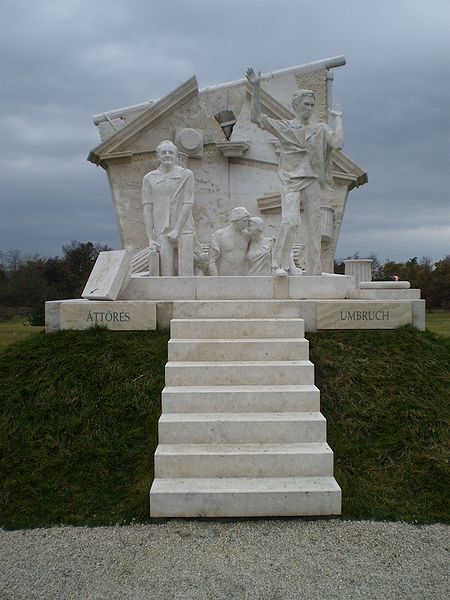




About 1991 - Monuments celebrating the Pan-European Picnic, Sopron (Austria/Hungary). "The Pan-European Picnic / Paneuropäisches Picknick / páneurópai piknik was a peace demonstration held on the Austrian-Hungarian border near the town of Sopron on 19 August 1989, an important event during the Revolutions of 1989 that led to the fall of the Iron Curtain & the reunification of Germany... The place of the picnic is marked by a monument of Miklós Melocco [left image], by a bell presented from the city of Debrecen (Hungary) from where the idea of the Picnic emerged, a pagoda presented by the Association of the Japanese–Hungarian Friendship and by a wooden monument unveiled by the organisors [sic] in 1991. A large artwork made by Gabriela von Habsburg, a daughter of Otto von Habsburg, & symbolizing a Cross & a barbed wire [right image] can be found at the Cave Theatre of Fertorakos (Hungary), a few kilometres from the site. Hungarian President László Sólyom unveiled a white marble monument in memory of those who had risked their life to cross the Iron Curtain."

February 7, 1992 - Provincial Government Buildings, Meuse River, Maastricht (Netherlands). Became "unintentional monument" with signing of the so-called Maastricht Treaty -- formally, the Treaty on European Union (TEU) -- by the members of the European Community. The TEU entered into force on November 1, 1993, during the Delors Commission. It created the European Union and led to the creation of the Euro.

1993 - Europen Parliament, Espace Léopold / Leopoldruimte, Brussels (Belgium). "Parliament has two meeting places, namely the Louise Weiss building in Strasbourg (France) which serves for twelve four-day plenary sessions per year and is the official seat, and the Espace Léopold (Dutch: Leopoldruimte) complex in Brussels (Belgium), the larger of the two, which serves for committee meetings, political groups and complementary plenary sessions."

1995 - European Court of Human Rights / Cour européenne des droits de l’homme, Strasbourg (France).



May 29, 1995 - Council of the European Union, Justus Lipsius Building, 175 Rue de la Loi, Brussels (Belgium). "The institution of the European Union (EU) responsible for defining the general political direction and priorities of the Union." Right image shows scupture 2000, outside the European Council Building.

P L A Q U E 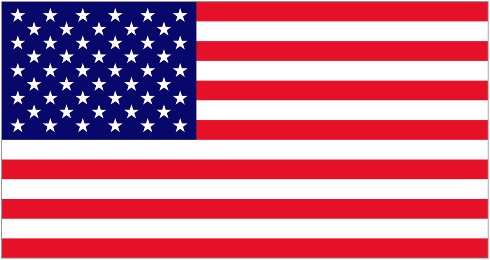
1997 - Jean Monnet Plaque, Willard Hotel, 1401 Pennsylvania Avenue, NW, Washington, DC (USA). Jean Monnet [1888-1979] is regarded by many as a chief architect of European Unity. He maintained an office in the Willard Hotel as a member of the British Mission in Washington during World War II.

S C U L P T U R E Date? - Bust of Jean Monnet, Viredespalais / Peace Palace, The Hague (Netherlands).

1999 - European Parliament, Immeuble Louise Weiss, Quartier Européen / European Quarter, Strasbourg (France). "Parliament has two meeting places, namely the Louise Weiss building in Strasbourg, France, which serves for twelve four-day plenary sessions per year and is the official seat, and the Espace Léopold (Dutch: Leopoldruimte) complex in Brussels, Belgium, the larger of the two, which serves for committee meetings, political groups and complementary plenary sessions."

S C U L P T U R E December 9, 2003 - Statue of Europe "Unity in Peace," Centre Erasmus, Jardin Van Maerlant. Brussels (Belgium). "Dedicated to Europe and offered to the European Commission by the French sculptor Bernard Romain. At the occasion of the year 2003 which was devoted to disabled people. Manufactured, modelled, polished and painted by children with challenged vision of different cultures under the supervision of Bernard Romain."


S C U L P T U R E June 11, 2009 - "Entropa," Prague (Czech Republic). "A €373,000 over-sized mosaic map of Europe...commissioned to mark the start of the Czech Republic’s six-month presidency of the European Union. Each of its interlocking segments was supposed to celebrate the union’s 27 member nations but instead offered satirical depictions: Italy was represented with a soccer field; Romania was shown as a Count Dracula theme park; a series of toilets stood in for Bulgaria."
P
L
A
Q
U
EJuly 27, 2012 - Plaque commemorating Count Richard Graf Coudenhove-Kalergi, Heiligen Kreuzer-Hof, Vienna (Austria). Google translation: "In this house, in the Pralatur Heiligenkreuzerhof lived the founder of the PanEuropean Union and spiritual father of the European agreement, RICHARD GRAF COUDENHOVE-KALERGI. From here, he fled in the night of 11 to 12 March 1938 the occupation forces of Nazi Germany. Austrian Pan European Association. To mark the 40 anniversary of his death on 27 July 2012." /// "Coudenhove-Kalergi, born November 16, 1894, in Tokyo (Japan); died July 27, 1972 in Schruns (Austria), was a Japanese Austrian writer, politician & founder of the Paneuropa movement." Information courtesy of Peter van den Dungen.


